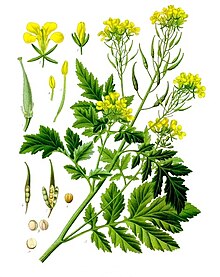White mustard
| White Mustard | |
|---|---|

| |
| Scientific classification | |
| Kingdom: | |
| (unranked): | |
| (unranked): | |
| (unranked): | |
| Order: | |
| Family: | |
| Genus: | |
| Species: | S. alba
|
| Binomial name | |
| Sinapis alba | |
- "Yellow mustard" redirects here. For information on the condiment yellow mustard, also known as "American mustard" (such as French's yellow mustard), see Mustard_(condiment)#Yellow_mustard.
White mustard (Sinapis alba) is an annual plant of the family Cruciferae. It is sometimes also referred to as Brassica alba or B hirta . Grown for its seeds, mustard, as fodder crop or as a green manure, it is now wide spread worldwide although it probably originated in the Mediterranean region.
Culinary uses
The yellow flowers of the plant produce hairy seed pods, with each pod containing roughly a half dozen seeds. These seeds are harvested just prior to the pods becoming ripe and bursting.
White mustard seeds are hard round seeds, usually around 1 to 1.5 millimetres in diameter[1], with a color ranging from beige or yellow to light brown. They can be used whole for pickling or toasted for use in dishes. When ground and mixed with other ingredients, a paste or more standard condiment can be produced.
The seeds contain sinalbin, which is a thioglycoside responsible for their pungent taste. White mustard has fewer volatile oils and the flavor is considered to be milder than that produced by black mustard seeds.[citation needed]
The blooming season of this plant (February-March) is celebrated with the Mustard Festival, a series of festivities in the Wine Country of California (Napa and Sonoma counties).[2]
See also
References
- ^ DAVID T. BALKE and LEVENTE L. DIOSADY; “Rapid aqueous extraction of mucilage from whole white mustard seed”; Food Research International; June 2000; 33 (5): pp. 347-356.
- ^ http://mustardfestival.org
External links
- http://www.maltawildplants.com/CRUC/Sinapis_alba.php Comprehensive profile for Sinapis alba.
